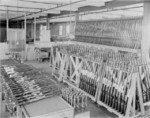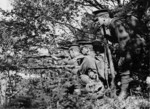Ross Rifle
| Country of Origin | Philippines |
| Type | Rifle |
| Caliber | 7.700 mm |
| Capacity | 5 rounds |
| Length | 1.320 m |
| Barrel Length | 774.000 mm |
| Weight | 3900.000 kg |
| Rate of Fire | 20 rounds/min |
Contributor: C. Peter Chen
ww2dbaseDuring the Second Boer War, the United Kingdom refused to grant Canada the license to produce the Lee-Enfield SMLE rifles locally. In response, Scottish inventor and land owner Sir Charles Ross offered a straight-pull rifle design of his own as well as the funding to construct a factory in Canada to produce them. The design contained several parts seemingly inspired or borrowed from the Mannlicher M1895 rifle design. This offer was accepted by the Liberal government of Sir Wilfrid Laurier and Ross was awarded his first contract in 1903 for 12,000 Mark I Ross rifles. The first 1,000 rifles were assigned to the Royal Northwest Mounted Police for testing, which rejected them due to many defects, but ultimately later variants corrected many of the problems seen in the original Mark I variant. In the 1910s, the United Kingdom encouraged standardization across the British Empire on Lee-Enfield rifles, but Canada chose to continue using the Ross rifles largely due to political reasons. In 1911, Morris Cohen secured a stock of 500 Ross rifles for the newly established Republic of China. During WW1, the First Canadian Contingent (later renamed 1st Canadian Division) of the Canadian Expeditionary Force arrived in France in Feb 1915 with Ross Model 10 rifles, but Canadian soldiers quickly complained of poor tolerance of dirt, unreliable bayonet fitting, and unpredictable compatibility with British-made ammunition, which was produced with lower tolerances than that of Canada's. Ross rifles' accuracy at long range, however, was better than that of Lee-Enfield SMLE rifles, thus making them a favorite among snipers. They were finally relegated to training roles for Canadian, British, and later American troops starting in Nov 1916. Ross rifles ceased production in 1918. Between 1903 and 1918, approximately 420,000 Ross rifles were produced, 342,040 of which were purchased by the British and about 20,000 by the Americans. Ross made a considerable fortune from the manufacturing and sale of these rifles.Around this time, the Dominion Rifle Factory in Quebec City in Canada converted a number of Ross rifles into the Huot automatic rifle, under the guidance of designer Joseph Alphonse Huot. At least 5 examples were made, but the design never entered production as WW1 ended and eliminating such demand.
In 1920 and 1921, British Coast guard units in Ireland were issued Ross rifles. During the Russian Revolution, a number of them were given to anti-Communist forces in Russia, Estonia, and Latvia; many of these weapons would become captured by the Soviets. During the Spanish Civil War, the Soviet Union gave a number them to the Spanish Republicans.
During WW2, the Royal Canadian Navy were issued Mark 3 Ross rifles, as was the Veteran's Guard of Canada, coastal defence units, training depots. In Britain, the same variant was issued to the Home Guard, Metropolitan Police, London Fire Brigade, and Port of London Authority Police. The Soviet Union also received Ross rifles as military assistance.
After WW2, Ross rifles were used by the Jewish paramilitary organization Haganah and the Dutch colonial administration in Dutch East Indies/Indonesia.
Source: Wikipedia ww2dbase
Last Major Revision: Mar 2020
Ross Rifle Mapa Interativo
Photographs
 |  |  |  |
Você gostou deste artigo ou achou este artigo útil? Se sim, considere nos apoiar no Patreon. Qualquer valor já vai ajudar! Obrigado. Por favor, ajude-nos a divulgar o site: Fique atualizado com WW2DB: |
Pesquisar WW2DB

Notícias
- » Wreck of Teruzuki Found (27 jul 2025)
- » USS Orlean's Bow Found (22 jul 2025)
- » The Emperor of Japan Planned to Honor WW2-era Japanese POWs in Mongolia (4 jul 2025)
- » US State Lawmaker John Winter Caught Using Racial Slur "Jap" and Apologized (11 jun 2025)
- » US Government Plans to Purge WW2 Information (17 mar 2025)
- » Ver todas as notícias
Estatísticas Atuais do Site
- » 1,181 biografias
- » 337 eventos
- » 45,111 entradas na linha do tempo
- » 1,246 navios
- » 350 modelos de aeronaves
- » 207 modelos de veículos
- » 376 modelos de armas
- » 123 documentos históricos
- » 261 instalações
- » 470 eventos
- » 28,472 fotos
- » 365 mapas
Citação Famosa da 2ª GM
"Among the men who fought on Iwo Jima, uncommon valor was a common virtue."Fleet Admiral Chester W. Nimitz, 16 Mar 1945
Apoie-nos
Por favor, considere nos apoiar no Patreon. Mesmo R$1 por mês já faz uma grande diferença. Obrigado!
Ou, por favor, nos apoie adquirindo alguns produtos do WW2DB na TeeSpring. Obrigado!